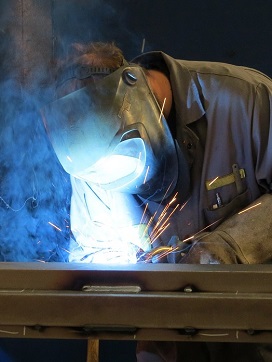Welding Smoke Eater
Why is it required?
Welding is an integral part of many industrial and manufacturing processes, but it also produces harmful fumes and particulates that pose serious health risks to workers. This is why welding smoke eaters are crucial pieces of safety equipment.
A welding smoke eater is a local exhaust system designed to capture fumes, smoke, and other airborne contaminants directly at the source before they can disperse into the breathing zones of welders and nearby workers.
Protecting employees from hazardous weld fume exposure is not just a best practice - it's a legal obligation under regulations set by OSHA, NIOSH, and other occupational safety bodies.
Prolonged inhalation of welding fumes can lead to respiratory illnesses, metal fume fever, lung cancer, and a variety of other acute and chronic health issues.
By effectively extracting these contaminants, welding smoke eaters create a safer breathing environment and significantly reduce the risks faced by machine operators and individuals in surrounding areas.
Welding smoke eaters are crucial for protecting worker health and safety, but understanding their importance requires examining the specific hazards of weld fumes and smoke.

Hazards of Welding Fumes and Smoke
Welding fume exposure can have severe negative impacts on the body, especially with prolonged or high concentration exposure. The particulates in weld smoke can become trapped in the respiratory system, potentially causing:
• Metal fume fever - A temporary illness with symptoms ranging from headache and fatigue to chest soreness and gastrointestinal pain, and can even result in convulsions and hallucinations.
• Lung effects - Bronchitis, air passage irritation, and a potential increased risk of lung cancer from chemicals like chromium and nickel compounds.
• Other chronic effects - Long-term overexposure may contribute to manganese neurological effects, kidney and liver damage, respiratory illnesses, and more.
These dangers are why regulations from OSHA, NIOSH, AWS, and other bodies mandate proper fume extraction and ventilation controls in welding areas.
What's in Welding Fumes?
The specific makeup of weld fumes varies based on:
• The base metal being welded (e.g. mild steel, stainless, aluminum
• Filler metals and electrode coatings
• The specific welding process and consumables involved
Some common fume components include:
• Metallic oxides like iron, chromium, nickel, manganese
• Fluoride compounds from fluxes
• Silicates
• Gases like ozone, carbon monoxide, nitrogen oxides
Welding Fume Regulations and Guidelines
Reducing hazardous weld fume exposure is not just a best practice - it's a legal requirement by multiple regulatory bodies. Employers must follow strict guidelines to protect workers from the dangers of welding smoke and fumes.
OSHA Welding Regulations
The Occupational Safety and Health Administration (OSHA) has established permissible exposure limits (PELs) for various welding fume components like:
• Chromium (VI) compounds: 5 μg/m3
• Nitrogen oxides: 5 ppm
• Fluorides: 2.5 mg/m3
• Aluminum and aluminum oxides: 15 mg/m3
OSHA's general duty clause also requires employers to provide a workplace "free from recognized hazards" including weld fumes (29 CFR 1910.134).
NIOSH Welding Guidelines
The National Institute for Occupational Safety and Health (NIOSH) provides recommended exposure limits (RELs) that are lower than OSHA PELs, including:
• Chromium (VI): 0.2 μg/m3
• Nitrogen oxides: 1 ppm
• Fluorides: 2.5 mg/m3
• Aluminum and aluminum oxides: 5 mg/m3
AWS Safety Standards
The American Welding Society's ANSI Z49.1 standard covers safety practices for cutting, allied processes, and includes requirements for ventilation and fume control measures.
In addition to following PELs and RELs, OSHA's respiratory protection standard (29 CFR 1910.134) mandates further measures like monitoring, medical surveillance, and providing proper PPE when engineering controls alone cannot limit exposures.
The dangers of weld smoke and fume exposure are well-documented, ranging from temporary metal fume fever to increased risks of lung disease and cancer with long-term overexposure. This is why implementing effective welding smoke eaters is not just a best practice - it's an obligation.
By capturing fumes and particulates at the source before they can disperse, welding smoke eaters create a safer breathing environment and dramatically reduce health risks for welders and adjacent workers.
However, proper use based on the specific application is crucial for maximizing their effectiveness. Factors like weld process, materials, ventilation needs, and anticipated fume levels must all be considered when selecting and positioning welding smoke eaters.
Maintaining compliance with OSHA, NIOSH, AWS and other regulatory guidelines on weld fume control is paramount for protecting employee health.
Welding smoke eaters are a vital engineering control, but additional measures like monitoring, medical surveillance, PPE and safe work practices are also often required to comprehensively limit hazardous exposures within legal limits.
You may also like:
• Commercial Air Pollutant Removal
• Why Choose Smokeeter?
• Everything You Need to Know About FS Smoke Eaters
